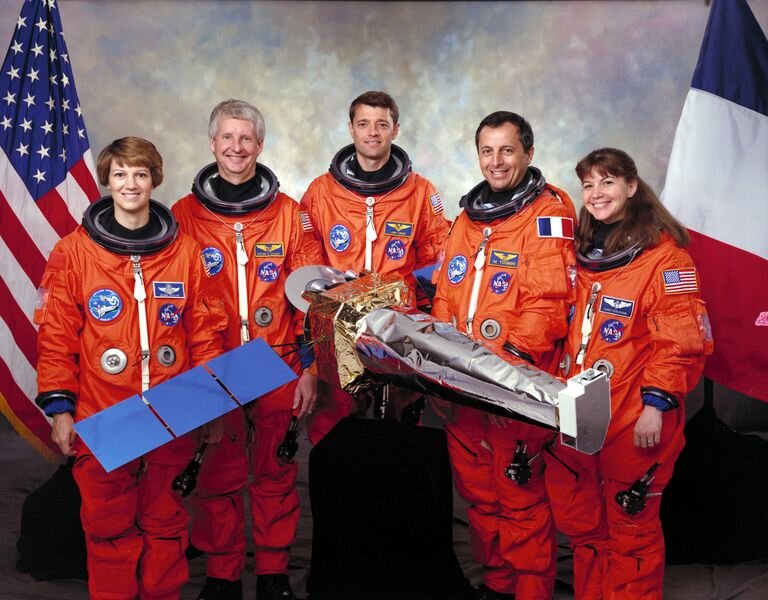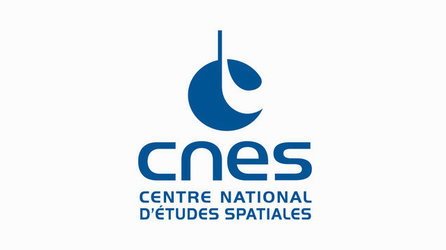Chandra X-Ray Observatory
STS-93 marked the 95th launch of the Space Shuttle, the 26th launch of Columbia, and the 21st night launch of a Space Shuttle. It had the first female Shuttle Commander.
Its primary payload was the Chandra X-ray Observatory. It would also be the last mission of Columbia until March 2002. During the interim, Columbia would be out of service for upgrading, and would not fly again until STS-109.
Five seconds after liftoff, an electrical short knocked out controllers for two main engines. The engines automatically switched to their backup controllers. Had a further short shut down two engines, the orbiter would have ditched into the ocean, although the crew could have possibly bailed out.
Concurrently a pin came loose inside one engine and ruptured a cooling line, allowing a hydrogen fuel leak. This caused premature fuel exhaustion, but the vehicle safely achieved a slightly lower orbit. Had the failure propagated further, a risky transatlantic or RTLS abort would have been required.
MISSION STATISTICS
Mission name: STS-93
Shuttle: Columbia
Number of crew members: 5
Launch:
23 July 1999, 12:31 a.m. EDT
Landing:
27 July 1999, 11:20 p.m. EDT
Duration: 4 days, 22 hours, 50 minutes, 18 seconds
Number of orbits: 80
CREW
- Eileen M. Collins (3), Mission Commander
- Jeffrey S. Ashby (1), Pilot
- Steven A. Hawley (5), Mission Specialist 1
- Catherine G. Coleman (2), Mission Specialist 2
- Michel Tognini (2), Mission Specialist 3 - CNES
(1) number of spaceflights each crew member has completed, including this mission

MISSION HIGHLIGHTS
The primary objective of the STS-93 mission was to deploy the Chandra X-ray Observatory (formerly Advanced X-ray Astrophysics Facility). At its launch, Chandra was the most sophisticated X-ray observatory ever built. It was designed to observe X-rays from high energy regions of the universe, such as hot gas in the remnants of exploded stars.
Other payloads on STS-93 included the Midcourse Space Experiment (MSX), the Shuttle Ionospheric Modification with Pulsed Local Exhaust (SIMPLEX), the Southwest Ultraviolet Imaging System (SWUIS), the Gelation of Sols: Applied Microgravity Research (GOSAMR) experiment, the Space Tissue Loss - B (STL-B) experiment, a Light Weight Flexible Solar Array Hinge (LFSAH), the Cell Culture Module (CCM), the Shuttle Amateur Radio Experiment - II (SAREX - II), EarthKAM, Plant Growth Investigations in Microgravity (PGIM), the Commercial Generic Bioprocessing Apparatus (CGBA), the Micro-Electrical Mechanical System (MEMS), and the Biological Research in Canisters (BRIC).
The Shuttle Ionespheric Modification with Pulsed Local Exhaust (SIMPLEX) payload activity researched the source of Very High Frequency (VHF) radar echoes caused by the orbiter and its OMS engine firings. The Principal Investigator (PI) used the collected data to examine the effects of orbital kinetic energy on ionospheric irregularities and to understand the processes that take place with the venting of exhaust materials. The Southwest Ultraviolet Imaging system (SWUIS) was based around a Maksutov-design ultraviolet (UV) telescope and a UV-sensitive, image-intensified Charge-Coupled Device (CCD) camera that frames at video frame rates. Scientists can obtain sensitive photometric measurements of astronomical targets.
The objective Gelation of Sols: Applied Microgravity Research (GOSAMR) experiment was to investigate the influence of microgravity on the processing of gelled sols. In particular, the purpose was to demonstrate that composite ceramic precursors composed of large particulates and small colloidal sols can be produced in space with more structural uniformity.
The focus of the Space Tissue Loss - B (STL-B) experiment was direct video observation of cells in culture through the use of a video microscope imaging system with the objective of demonstrating near real-time interactive operations to detect and induce cellular responses.
The Light Weight Flexible Solar Array Hinge (LFSAH) payload consists of several hinges fabricated from shape memory alloys. Shape memory deployment hinges offered controlled shockless deployment of solar arrays and other spacecraft appendages. LFSAH demonstrated this deployment capability for a number of hinge configurations.
The objectives of the Cell Culture Module (CCM) were to validate models for muscle, bone, and endothelial cell biochemical and functional loss induced by microgravity stress; to evaluate cytoskeleton, metabolism, membrane integrity and protease activity in target cells; and to test tissue loss medications.
The Shuttle Amateur Radio Experiment (SAREX-II) demonstrated the feasibility of amateur short-wave radio contacts between the shuttle and ground-based amateur radio operators. SAREX also served as an educational opportunity for schools around the world to learn about space by speaking directly to astronauts aboard the shuttle via amateur radio.
The EarthKAM payload conducted Earth observations using the Electronic Still Camera (ESC) installed in the overhead starboard window of the Aft Flight Deck.
The Plant Growth Investigations in Microgravity (PGIM) payload experiment used plants to monitor the space flight environment for stressful conditions that affect plant growth. Because plants cannot move away from stressful conditions, they have developed mechanisms that monitor their environment and direct effective physiological responses to harmful conditions.
The Commercial Generic Bioprocessing Apparatus (CGBA) payload hardware allows for sample processing and stowage functions. The Generic Bioprocessing Apparatus - Isothermal Containment Module (GBA-ICM) is temperature controlled to maintain a preset temperature environment, controls the activation and termination of the experiment samples, and provides an interface for crew interaction, control and data transfer.
The Micro-Electrical Mechanical System (MEMS) payload examines the performance, under launch, microgravity, and reentry conditions of a suite of MEMS devices. These devices include accelerometers, gyroscopes, and environmental and chemical sensors. The MEMS payload is self-contained and requires activation and deactivation only.
The Biological Research in Canisters (BRIC) payload was designed to investigate the effects of space flight on small arthropod animals and plant specimens. The flight crew was available at regular intervals to monitor and control payload/experiment operations.
Columbia's landing at Kennedy Space Center marked the 12th night landing in the Shuttle program's history. Five have been at Edwards Air Force Base in California and the rest have been at KSC. There have been 19 consecutive landings at KSC and 25 of the last 26 have been there.















 Germany
Germany
 Austria
Austria
 Belgium
Belgium
 Denmark
Denmark
 Spain
Spain
 Estonia
Estonia
 Finland
Finland
 France
France
 Greece
Greece
 Hungary
Hungary
 Ireland
Ireland
 Italy
Italy
 Luxembourg
Luxembourg
 Norway
Norway
 The Netherlands
The Netherlands
 Poland
Poland
 Portugal
Portugal
 Czechia
Czechia
 Romania
Romania
 United Kingdom
United Kingdom
 Slovenia
Slovenia
 Sweden
Sweden
 Switzerland
Switzerland





























